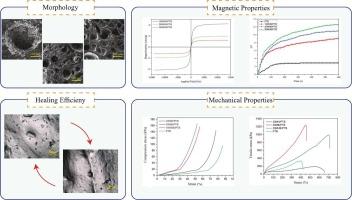含Fe3O4/羟基磷灰石/生物玻璃的磁性和生物活性自愈pva基水凝胶:物理化学,机械和体外生物学评估
IF 5.1
3区 工程技术
Q1 CHEMISTRY, APPLIED
引用次数: 0
摘要
本研究介绍了一种新型的自修复聚乙烯醇基水凝胶,与硼砂和单宁酸交联,结合了磁铁矿纳米颗粒(MNPs)、羟基磷灰石纳米颗粒(HANPs)和锌、锰、银掺杂的生物活性玻璃纳米颗粒(BGNPs)。结构分析(XRD, FTIR)证实了合成成功,SEM对其形貌进行了表征。水凝胶表现出超顺磁性行为,较高的MNP浓度在交变磁场下引起热疗,温度升高高达12°C。最佳配方具有高溶胀能力(711%),杨氏模量为280 kPa,韧性为3250 kJ/cm3,强调其适合骨再生。生物活性研究显示羟基磷灰石在模拟体液中形成,证实了骨结合的潜力。在细胞毒性试验中,水凝胶在抗拉强度和细胞增殖方面达到40%的自愈效率。抗菌试验显示对革兰氏阳性和革兰氏阴性细菌有效。这些特点使这种水凝胶成为一种动态的生物材料,用于先进的骨相关治疗和工程应用。本文章由计算机程序翻译,如有差异,请以英文原文为准。

Magnetic and bioactive self-healing PVA-based hydrogels containing Fe3O4/hydroxyapatite/bioglass: Physicochemical, mechanical, and in vitro biological assessments
This study introduces a novel self-healing polyvinyl alcohol-based hydrogel cross-linked with borax and tannic acid, incorporating magnetite nanoparticles (MNPs), hydroxyapatite nanoparticles (HANPs), and Zn-, Mn-, and Ag-doped bioactive glass nanoparticles (BGNPs). Structural analyses (XRD, FTIR) confirmed successful synthesis, and SEM characterized the morphology. The hydrogel exhibited superparamagnetic behavior, with higher MNP concentrations inducing hyperthermia under an alternating magnetic field, raising temperatures by up to 12 °C. The optimal formulation demonstrated high swelling capacity (711 %), a Young's modulus of 280 kPa, and toughness of 3250 kJ/cm3, emphasizing its suitability for bone regeneration. Bioactivity studies revealed hydroxyapatite formation in simulated body fluid, confirming bone-bonding potential. The hydrogel achieved 40 % self-healing efficiency in tensile strength and enhanced cell proliferation in cytotoxicity assays. Antimicrobial tests showed effectiveness against gram-positive and gram-negative bacteria. These features establish this hydrogel as a dynamic biomaterial for advanced bone-related therapies and engineering applications.
求助全文
通过发布文献求助,成功后即可免费获取论文全文。
去求助
来源期刊

Reactive & Functional Polymers
工程技术-高分子科学
CiteScore
8.90
自引率
5.90%
发文量
259
审稿时长
27 days
期刊介绍:
Reactive & Functional Polymers provides a forum to disseminate original ideas, concepts and developments in the science and technology of polymers with functional groups, which impart specific chemical reactivity or physical, chemical, structural, biological, and pharmacological functionality. The scope covers organic polymers, acting for instance as reagents, catalysts, templates, ion-exchangers, selective sorbents, chelating or antimicrobial agents, drug carriers, sensors, membranes, and hydrogels. This also includes reactive cross-linkable prepolymers and high-performance thermosetting polymers, natural or degradable polymers, conducting polymers, and porous polymers.
Original research articles must contain thorough molecular and material characterization data on synthesis of the above polymers in combination with their applications. Applications include but are not limited to catalysis, water or effluent treatment, separations and recovery, electronics and information storage, energy conversion, encapsulation, or adhesion.
 求助内容:
求助内容: 应助结果提醒方式:
应助结果提醒方式:


